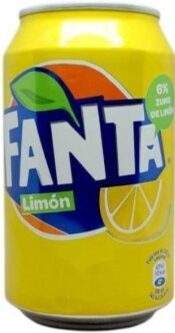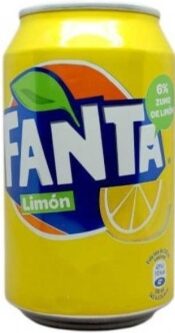Fanta Citron frappé - 330 ml
This product page is not complete. You can help to complete it by editing it and adding more data from the photos we have, or by taking more photos using the app for Android or iPhone/iPad. Thank you!
×
Barcode: 5449000006004 (EAN / EAN-13)
Common name: Bebida refrescante de zumo de frutas, con azúcar y edulcorantes
Quantity: 330 ml
Packaging: Metal, Can, Drink can, Aluminium-can, Aluminium-tin, es:Green dot
Brands: Fanta
Categories: Plant-based foods and beverages, Beverages, Plant-based foods, Fruits and vegetables based foods, Fruits based foods, Plant-based beverages, Carbonated drinks, Fruit-based beverages, Fruits, Artificially sweetened beverages, Citrus, Sodas, Fruit sodas, Lemons, Lemon soft drinks, Sweetened beverages
Labels, certifications, awards:
Contains a source of phenylalanine, Green Dot, With sweeteners
Link to the product page on the official site of the producer: https://www.cocacola.es/fanta/es/product...
Matching with your preferences
Environment
Packaging
Transportation
Report a problem
Data sources
Product added on by jeanbono
Last edit of product page on by redspider.
Product page also edited by alia, beniben, ecoscore-impact-estimator, elfarto, elliottslab, hubbit200, inf, ismael12, kiliweb, musarana, openfoodfacts-contributors, packbot, quechoisir, roboto-app, scanbot, stephane, swipe-studio, tacite, teolemon, thaialagata, youplaboum, yuka.SGFzNkNJTUt2Y2traHZZdThETHIrdE5UM01XYlVHUzZHOWdmSWc9PQ, yuka.U1lNYVBiWUZ1Y0Vwdy9OaDR4bk4vOHBseTVXaUJqT3ZJZHN4SUE9PQ, yuka.V1lrNExJZ2UrdklJdDg4NjdpUDgvTXR3NTcyamJ6M3VGZVFmSVE9PQ, yuka.VnFZdUNZWVFsdGdTaGNZZHJpL3FvWWg4NW83M1YyTzZLZU1zSVE9PQ, yuka.WDY0NUdyWXh2dEFXdnNNYjVpUHc2dEI1MXE3eVlqdWxPL01iSVE9PQ, yuka.Wlp3Q1Q2WmRxdDhxb3ZRRTNDSDZ3L05Md2I2TlQwYStBY29OSWc9PQ, yuka.YUtNcks1VXptZWNKbnZCajdCVHhwTXhVMXNhaURET0ZFK3NUSVE9PQ, yuka.YjRrWkhvYzVsTUVVdWNFZXhEVG94OXhzNXBXemQwQ29FTFpQSUE9PQ, yuka.ZnFzTVBJSVFvZU1Bbk1RbXJ4TGs0OWROeXJ1N2ZrZnBHZVVjSVE9PQ, yuka.sY2b0xO6T85zoF3NwEKvlhdlTNTMpwOdBiTWh0qT6dqFK6LTY8ti6ZHoYqo, yuka.sY2b0xO6T85zoF3NwEKvlkxceuPQqGz2Cy7TwmGUxvuqEbLSe_B066Txaas, yuka.sY2b0xO6T85zoF3NwEKvllwfT8bhkyDULCDStHOm99OeEYDmRsEt67DQNag, yuka.sY2b0xO6T85zoF3NwEKvlm1rUvODqTzBORLkpW-C29OxNrflQoEi_Zrlbas, yuka.sY2b0xO6T85zoF3NwEKvlmpLDPrsphmcGT34km7W6vCQBYXwONt884L7I6s, yuka.sY2b0xO6T85zoF3NwEKvlmpuT8Llsmr5KCLtskKI_vShHrDPU8t58rLCIqs, yuka.sY2b0xO6T85zoF3NwEKvln1ZCoqFnmL4HETUs2bXxPmjN5uzXct_sq3UL6s, yuka.sY2b0xO6T85zoF3NwEKvlnAcX_z_ixboJRDTi3W75O-NdrjvaN9duor_Iqs, yuka.sY2b0xO6T85zoF3NwEKvlnB9foDlhC-ZCQ3mtG6qnYyhc5W3eex8wdjqIqs, yukafix.








